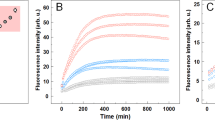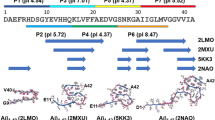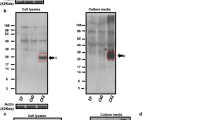Abstract
We report here that a monomeric de novo designed α-helix-turn-α-helix peptide, αtα, when incubated at 37 °C in an aqueous buffer at neutral pH, forms nonbranching, protease resistant fibrils that are 6–10 nm in diameter. These fibrils are rich in β-sheet and bind the amyloidophilic dye Congo red. αtα fibrils thus display the morphologic, structural, and tinctorial properties of authentic amyloid fibrils. Surprisingly, unlike fibrils formed by peptides such as the amyloid β-protein or the islet amyloid polypeptide, αtα fibrils were not toxic to cultured rat primary cortical neurons or PC12 cells. These results suggest that the potential to form fibrils under physiologic conditions is not limited to those proteins associated with amyloidoses and that fibril formation alone is not predictive of cytotoxic activity.
This is a preview of subscription content, access via your institution
Access options
Subscribe to this journal
Receive 12 print issues and online access
$189.00 per year
only $15.75 per issue
Buy this article
- Purchase on Springer Link
- Instant access to full article PDF
Prices may be subject to local taxes which are calculated during checkout





Similar content being viewed by others
References
Kelly, J.W. Curr. Opin. Struct. Biol. 8, 101–106 (1998).
Pike, C.J., Burdick, D., Walencewicz, A.J., Glabe, C.G. & Cotman, C.W. J. Neurosci. 13, 1676–1687 (1993).
Lambert, M.P. et al. Proc. Natl. Acad. Sci. USA 95, 6448 –6453 (1998).
Walsh, D.M. et al. J. Biol. Chem. 274, 25945– 25952 (1999).
Hartley, D.M. et al. J. Neurosci. 19, 8876– 8884 (1999).
Chiti, F. et al. Proc. Natl. Acad. Sci. USA 96, 3590– 3594 (1999).
Guijarro, J.I., Sunde, M., Jones, J.A., Campbell, I.D. & Dobson, C.M. Proc. Natl. Acad. Sci. USA 95, 4224–4228 ( 1998).
Gross, M. et al. Protein Sci. 8, 1350– 1357 (1999).
Fezoui, Y., Weaver, D.L. & Osterhout, J.J. Proc. Natl. Acad. Sci. USA 91, 3675–3679 (1994).
Fezoui, Y., Connolly, P.J. & Osterhout, J.J. Protein Sci. 6, 1869– 1877 (1997).
Goldsbury, C.S. et al. J. Struct. Biol. 119, 17– 27 (1997).
Harper, J.D., Lansbury, P.T.., Jr. Annu. Rev. Biochem. 66, 385–407 ( 1997).
Glenner, G.G. Prog. Histochem. Cytochem. 13, 1–37 (1981).
Fezoui, Y., Braswell, E.H., Xian, W. & Osterhout, J.J. Biochemistry 38, 2796–2804 (1999).
Chakrabartty, A., Kortemme, T. & Baldwin, R.L. Protein Sci. 3, 843–852 (1994).
Fezoui, Y., Weaver, D.L. & Osterhout, J.J. Protein Sci. 4, 286– 295 (1995).
Lumb, K.J. & Kim, P.S. Science 268 , 436–439 (1995).
Zhou, N.E., Kay, C.M. & Hodges, R.S. Protein Eng. 7, 1365– 1372 (1994).
Kuwajima, K. In Circular dichroism and the conformational analysis of biomolecules (ed., Fasman, G.D.) 159–182 (Plenum Press, New York; 1996).
Harrison, P.M., Bamborough, P., Daggett, V., Prusiner, S.B. & Cohen, F.E. Curr. Opin. Struct. Biol. 7, 53–59 ( 1997).
Lai, Z., Colon, W. & Kelly, J.W. Biochemistry 35, 6470– 6482 (1996).
Booth, D.R. et al. Nature 385, 787–793 (1997).
Takahashi, Y., Ueno, A. & Mihara, H. Bioorg. Med. Chem. 7, 177– 185 (1999).
Mihara, H., Takahashi, Y. & Ueno, A. Biopolymers 47, 83– 92 (1998).
Takahashi, Y., Ueno, A. & Mihara, H. Chem. Eur. J. 4, 2475– 2484 (1998).
Geula, C. et al. Nature Med. 4, 827–831 (1998).
Abe, K. & Saito, H. Brain Res. 830, 146–154 (1999).
Cooper, G.J. et al. Proc. Natl. Acad. Sci. USA 84, 8628 –8632 (1987).
Walsh, D.M., Lomakin, A., Benedek, G.B., Condron, M.M. & Teplow, D.B. J. Biol. Chem. 272, 22364–22372 (1997).
Fezoui, Y. et al. Amyloid: Int. J. Exp. Clin. Invest. 7, 166–178 (2000).
Koradi, R., Billeter, M. & Wuthrich, K. J. Mol. Graphics 14, 51– 55 (1996).
Acknowledgements
We thank C. Lemere for assistance with the birefringence experiment, A. Bissello for performing mass spectroscopy, S. Vasquez for preparation of primary neuronal cultures, and M. Condron for peptide synthesis and amino acid analysis. This work was supported by grants from the National Institutes of Health (D.B.T., D.J.S., and Y.F.), and by the Foundation for Neurologic Diseases (D.B.T and D.J.S.).
Author information
Authors and Affiliations
Corresponding authors
Rights and permissions
About this article
Cite this article
Fezoui, Y., Hartley, D., Walsh, D. et al. A de novo designed helix-turn-helix peptide forms nontoxic amyloid fibrils. Nat Struct Mol Biol 7, 1095–1099 (2000). https://doi.org/10.1038/81937
Received:
Accepted:
Issue Date:
DOI: https://doi.org/10.1038/81937
This article is cited by
-
Neuroprotective effect of Bis(Indolyl)phenylmethane in Alzheimer’s disease rat model through inhibition of hen Lysozyme amyloid fibril-induced neurotoxicity
Journal of the Iranian Chemical Society (2023)
-
Metformin activates chaperone-mediated autophagy and improves disease pathologies in an Alzheimer disease mouse model
Protein & Cell (2021)
-
Diversity in αβ and βα Loop Connections in TIM Barrel Proteins: Implications for Stability and Design of the Fold
Interdisciplinary Sciences: Computational Life Sciences (2018)
-
Interaction of the amyloid β peptide with sodium dodecyl sulfate as a membrane-mimicking detergent
Journal of Biological Physics (2016)
-
Conformational Transitions Provoked by Organic Solvents in Chicken Egg Ovalbumin: Mimicking the Local Environment
The Protein Journal (2013)



